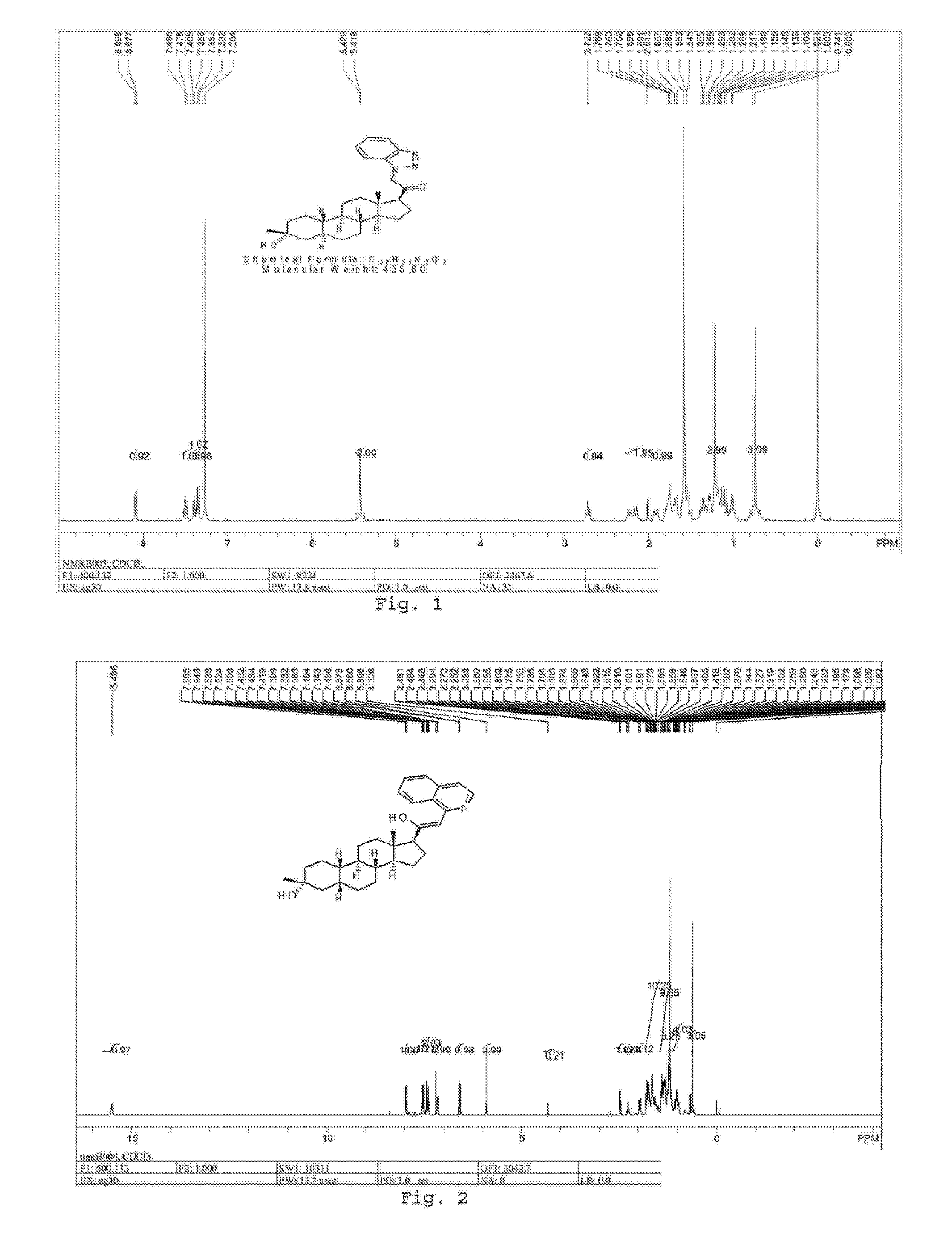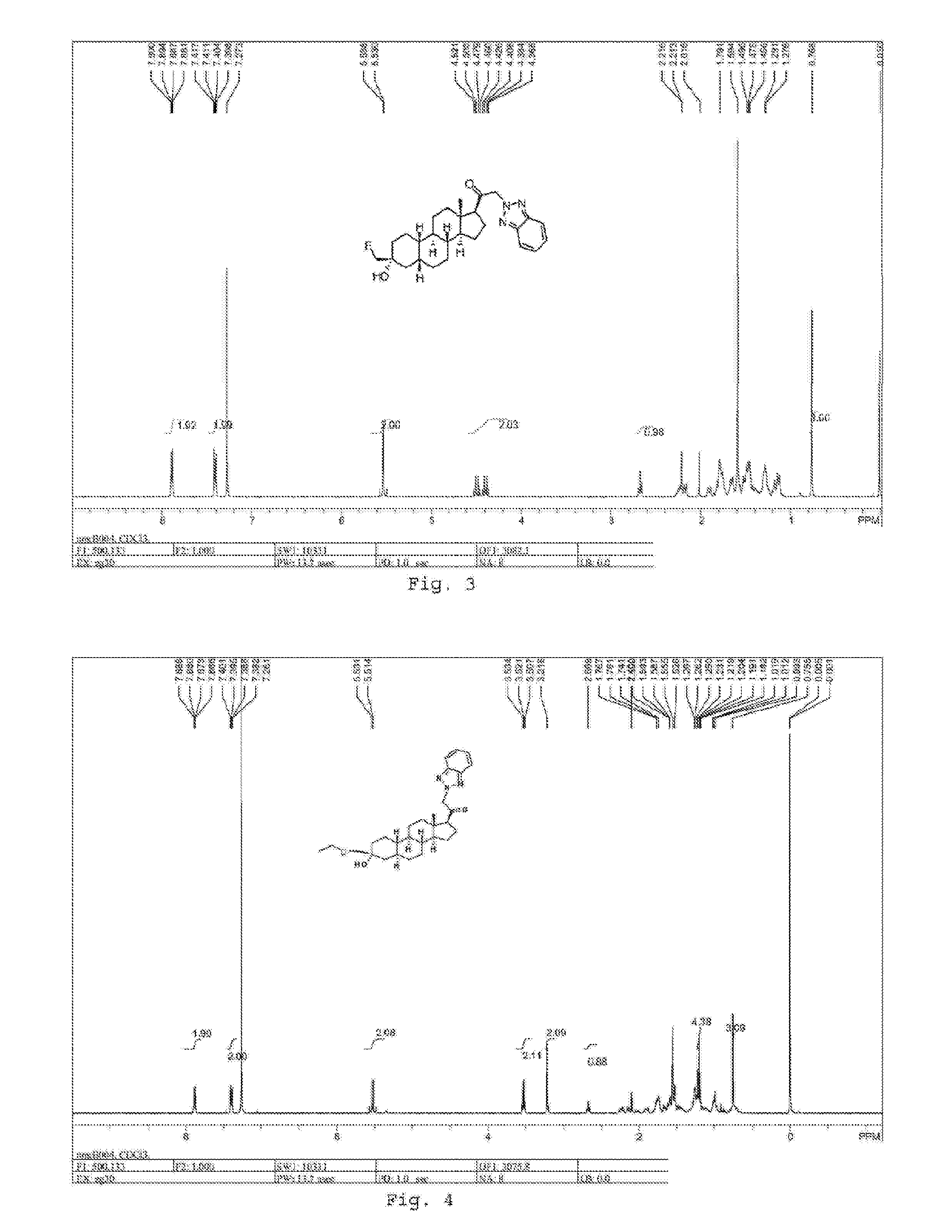19-NOR neuroactive steroids and methods of use thereof
a neuroactive steroid and neuroactive technology, applied in the field of neuroactive steroids, can solve the problems that progesterone is not consistently effective in the treatment of the aforementioned syndromes, and achieve the effects of preventing further metabolism, reducing the potential for oxidation of the hydroxy moiety, and reducing the risk of side effects
- Summary
- Abstract
- Description
- Claims
- Application Information
AI Technical Summary
Benefits of technology
Problems solved by technology
Method used
Image
Examples
example 1
Synthesis of SA and SA Intermediates
[0311]
Synthesis of Compound SA-B
[0312]Compound SA (50 g, 184 mmol) and palladium black (2.5 g) in tetrahydrofuran (300 mL) and concentrated hydrobromic acid (1.0 mL) was hydrogenated with 10 atm hydrogen. After stirring at room temperature for 24 h, the mixture was filtered through a pad of celite and the filtrate was concentrated in vacuo to afford the crude compound. Recrystallization from acetone gave compound SA-B (42.0 g, yield: 83.4%) as white powder.
[0313]1H NMR: (400 MHz, CDCl3) δ 2.45-2.41 (m, 1H), 2.11-3.44 (m, 2H), 3.24 (s, 3H), 2.18-2.15 (m, 1H), 2.01-1.95 (m, 1H), 1.81-1.57 (m, 7H), 1.53-1.37 (m, 7H), 1.29-1.13 (m, 3H), 1.13-0.90 (m, 2H), 0.89 (s, 3H).
Synthesis of Compound SA-C
[0314]A solution of SA-B (42.0 g, 153.06 mmol) in 600 mL anhydrous toluene was added dropwise to the MAD (459.19 mmol, 3.0 eq, freshly prepared) solution under N2 at −78° C. After the addition was completed, the reaction mixture was stirred for 1 hr at −78° C. T...
example 2
Synthesis of Compounds SA-1 and SA-2
[0319]
[0320]To a suspension of K2CO3 (50 mg, 0.36 mmol) in THF (5 mL) was added 1H-benzo[d][1,2,3]triazolel (80 mg, 0.67 mmol) and compound SA (100 mg, 0.25 mmol). The mixture was stirred at rt for 15 h. The reaction mixture was poured in to 5 mL H2O and extracted with EtOAc (2×10 mL). The combined organic layers were washed with brine, dried over sodium sulfate, filtered and concentrated. The residue was purified with by reverse-phase prep-HPLC to afford the title compound as a white solid compound SA-1 (15 mg, 13.7%) and compound SA-2 (10 mg, 9.2%). Compound SA-1: 1HNMR (500 MHz, CDCl3), δ (ppm), 8.08 (d, 1H), 7.49 (t, 1H), 7.38 (t, 1H), 7.33 (d, 1H), 5.44 (1H, AB), 5.40 (1H, AB), 2.70 (t, 1H), 0.73 (s, 3H). Compound SA2: 1HNMR (500 MHz, CDCl3), δ (ppm), 7.88 (d, 2H), 7.39 (d, 2H), 5.53-5.52 (m, 2H), 2.65 (t, 1H), 0.75 (s, 3H).
example 3
Synthesis of Compounds SA-3 and SA-4
[0321]
[0322]To a suspension of K2CO3 (50 mg, 0.36 mmol) in THF (5 mL) was added 1H-pyrazolo[4,3-b]pyridine (80 mg, 0.67 mmol) and compound SA (100 mg, 0.25 mmol). The mixture was stirred at rt for 15 h. The reaction mixture was poured in to 5 mL H2O and extracted with EtOAc (2×10 mL). The combined organic layers were washed with brine, dried over sodium sulfate, filtered and concentrated. The residue was purified with by reverse-phase prep-HPLC to afford the title compound as a white solid compound SA-3 (17 mg, 15.5%) and compound SA-4 (10 mg, 9.2%). Compound SA-3: 1HNMR (400 MHz, CDCl3), δ (ppm), 8.59 (d, 1H), 8.28 (s, 1H), 7.59 (d, 1H), 7.29 (dd, 1H), 5.20 (1H, AB), 5.13 (1H, AB) 2.67 (t, 1H), 0.71 (s, 3H). Compound SA-4: 1HNMR (400 MHz, CDCl3), δ (ppm), 8.58 (d, 1H), 8.22 (s, 1H), 8.04 (d, 1H), 7.25 (dd, 1H), 5.28 (1H, AB), 5.19 (1H, AB). 2.67 (t, 1H) 0.72 (s, 3H).
PUM
 Login to View More
Login to View More Abstract
Description
Claims
Application Information
 Login to View More
Login to View More - R&D
- Intellectual Property
- Life Sciences
- Materials
- Tech Scout
- Unparalleled Data Quality
- Higher Quality Content
- 60% Fewer Hallucinations
Browse by: Latest US Patents, China's latest patents, Technical Efficacy Thesaurus, Application Domain, Technology Topic, Popular Technical Reports.
© 2025 PatSnap. All rights reserved.Legal|Privacy policy|Modern Slavery Act Transparency Statement|Sitemap|About US| Contact US: help@patsnap.com



